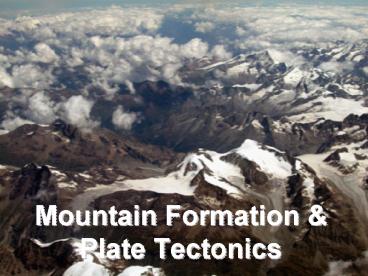Mountain Formation PowerPoint PPT Presentation
1 / 24
Title: Mountain Formation
1
- Mountain Formation Plate Tectonics
2
Continental Margins
- Continental margins are the boundaries where
oceanic crust and continental crust meet (this is
not always a plate boundary) - There are 2 types of margins
- ACTIVE
- PASSIVE
3
Active continental margins
- occur along plate boundaries where the plates are
moving (active) - Earthquakes, volcanoes, and mountain formation
all occur along active continental margins - The subduction of the Nazca plate under the South
American plate is an active continental margin
(the Andes Mountains are formed here)
4
(No Transcript)
5
(No Transcript)
6
Passive continental margins
- Do Not occur along plate boundaries
- (no movement passive)
- major geologic activity along these margins is
the erosion deposition of sediment - The east coast of the United States is a passive
continental margin
7
(No Transcript)
8
(No Transcript)
9
Mountain Formation by Collisions
10
Oceanic - Continental Crust
- oceanic crust subducts under the continental
crust (remember, oceanic is more dense) - This subduction causes rock layers to be pushed
upward, forming mountains along the coastline - Magma is also forced upward, sometimes causing
the mountains that are forming to become volcanic
(ex. the Andes Mountains along the coast of South
America)
11
Collisions of two continents
- Since the continental crust is too light to
subduct, they collide and crumble along the
edges, and push upward (uplift) - The Himalayan Mountains, with Mt. Everest, are
formed by the Indian plate and the Eurasian plate
colliding - Mt. Everest is still getting higher!
12
(No Transcript)
13
Surface Features with Mountain Formation
- The Earths crust usually moves along a break or
crack called a fault (a crack in the crust with
no movement is called a joint) - There are three main types of faults
- Normal
- Reverse
- Strike-Slip
14
(No Transcript)
15
(No Transcript)
16
Folding
- Layers of rocks can be folded as collisions occur
(just like if you push the edges of a piece of
paper together) - If the layers fold upward, it is called an
anticline (the upward folds form the outline of
the letter A) - If the layers fold downward, it is called a
syncline (think of where you go if you sin) ?
17
(No Transcript)
18
(No Transcript)
19
(No Transcript)
20
(No Transcript)
21
(No Transcript)
22
(No Transcript)
23
(No Transcript)
24
(No Transcript)

